Don't wanna be here? Send us removal request.
Text
(14/10/2024)
KVB222 -Assessment 2 Journal (Week 11)
Site:
After revisiting the site and taking more photos I began measuring the space. I documented a length of 15 meters, a maximum height of 4 meters and a maximum width of 5 meters. I was also able to pin point where exactly my site was located on a map of the park where i discovered my artwork would be located on the left most side of the fair. I also now notice my site is accessible via a footpath to it's left which should allow more suitability to a wider range of audiences.
Once I had documented the details of the site I began calculating the scale of my module. This lead me to a 1:25 ratio of the theoretical full scale artwork.

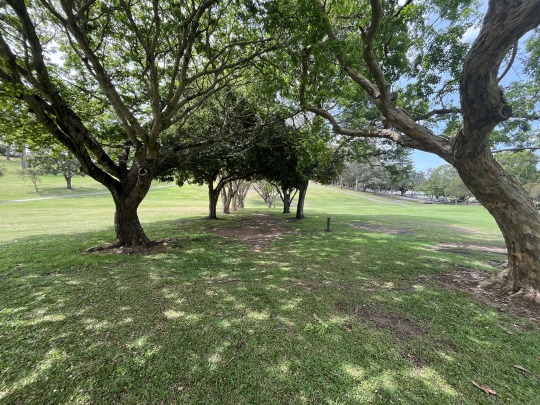
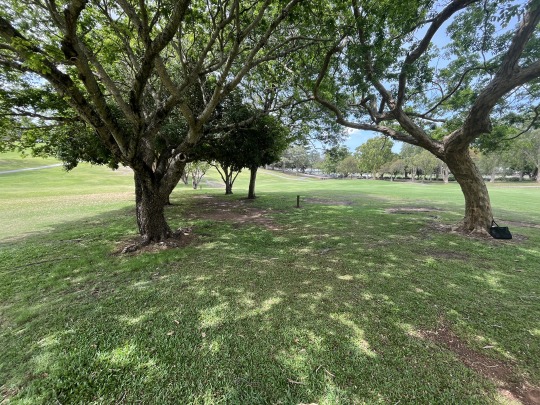
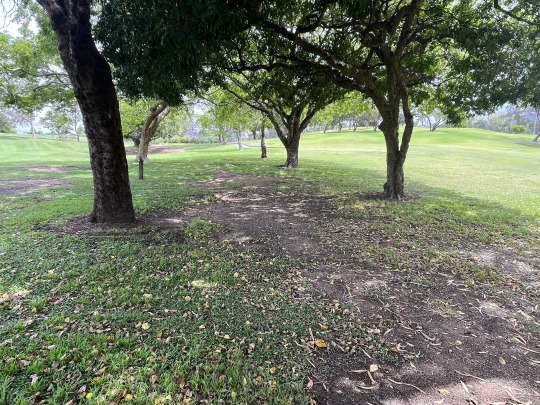
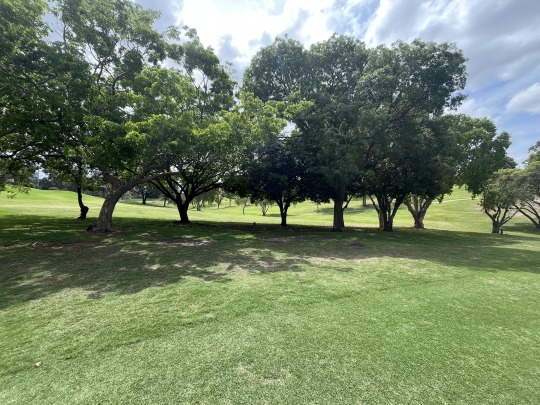
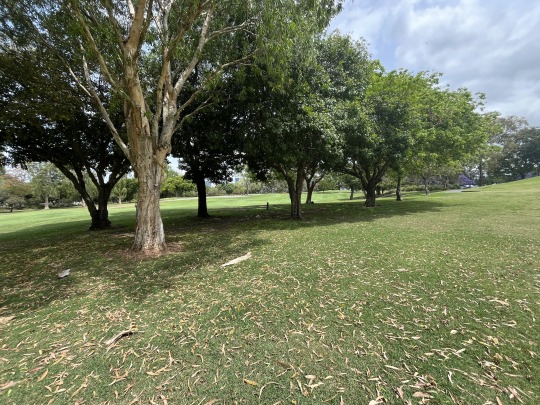
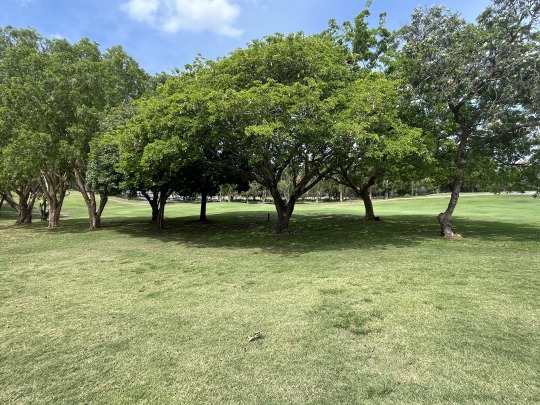
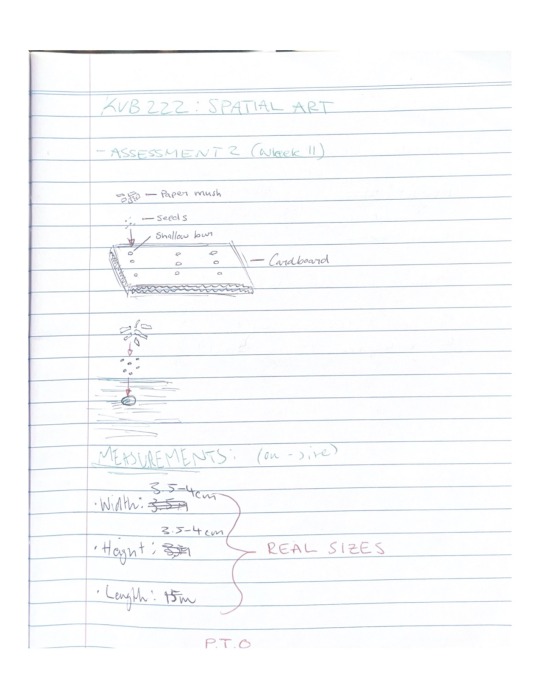
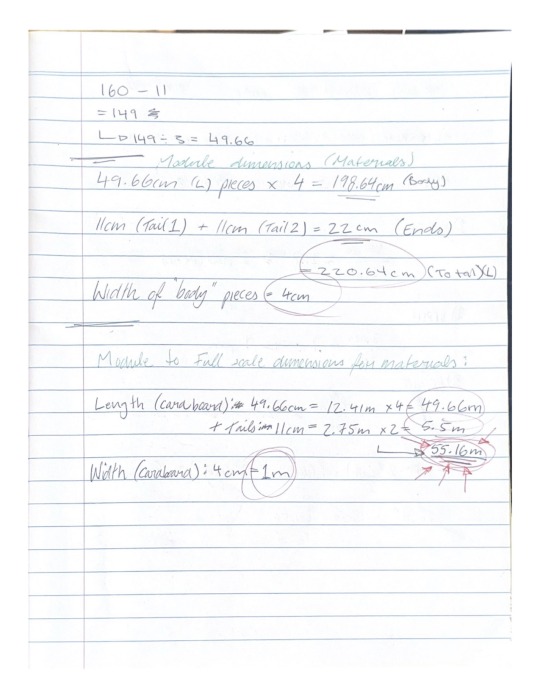
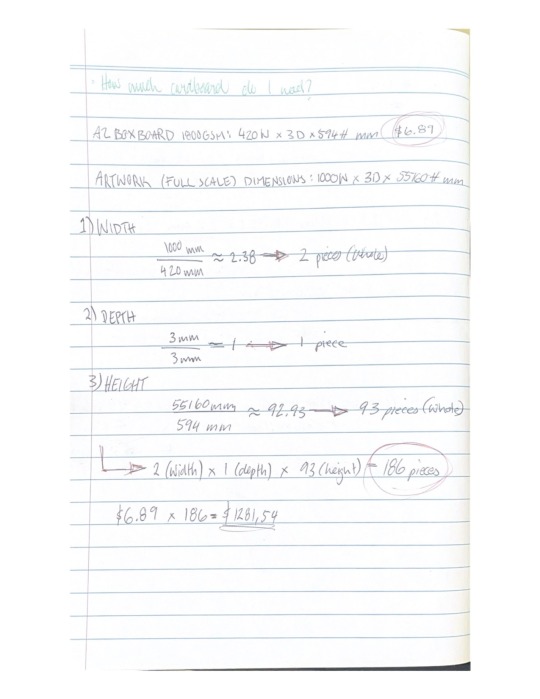
Module:
To fabricate my module I wanted to adhere as closely to the materials I would use for the large scale work as possible. This lead me to solely use discarded cardboard from the Z10 scrap bin. The process was simplified to cutting the cardboard into 4 X 49.66cm body pieces and 2 X 11cm tail ends with a width of 4 cm (the equivalent to 1m full size). This made the piece 220.64cm long before being bent to shape and suspended (the equivalent of 55.16m full size).
Each piece of the module was then stapled together and reinforced with a cardboard strip to prevent tearing. Once the piece was assembled it was gently bent to create curves and shaped into a spiraling/curling tunnel form. To make certain ares bend more it was sprayed with water to soften the cardboard and in some areas suspended or secured with tape. The work however, wont be using tape or any kind of synthetic adhesive but rather jute twine which will raise the work and secure it to the trees and ground.
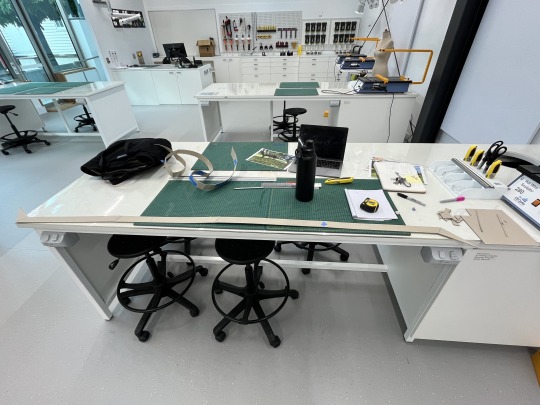
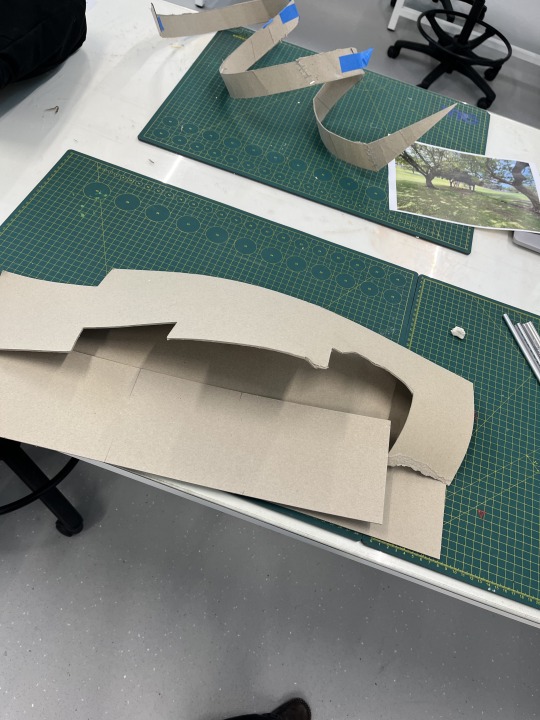
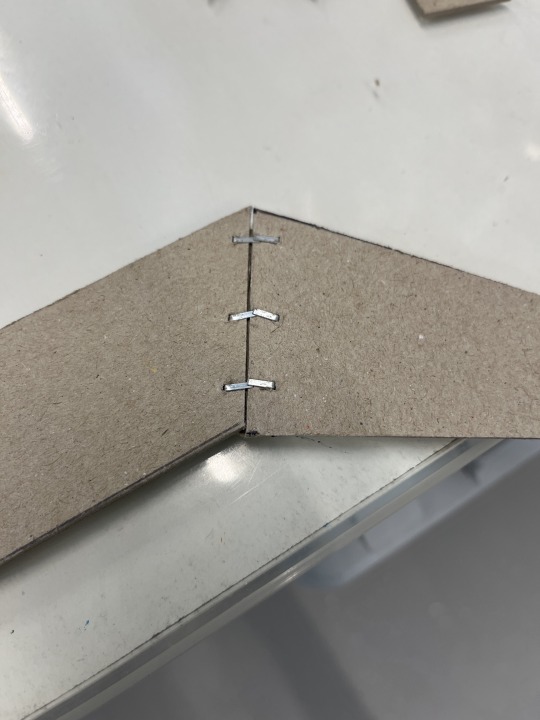
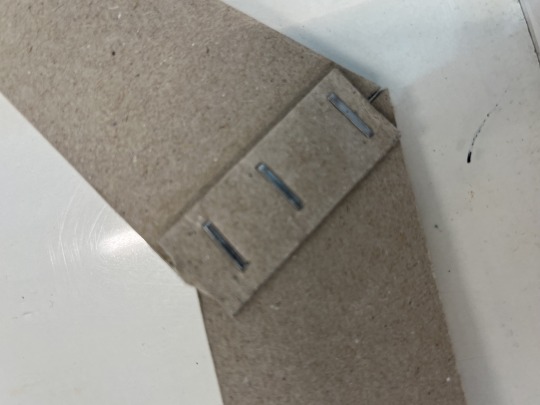
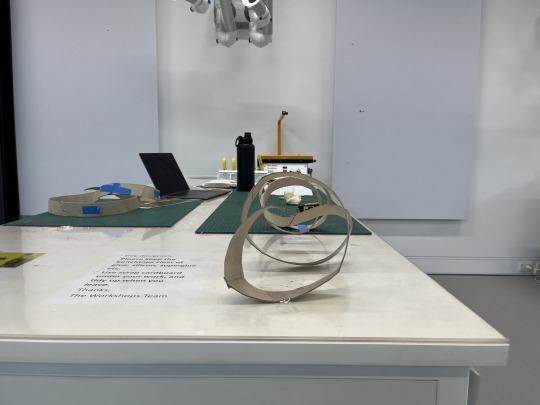
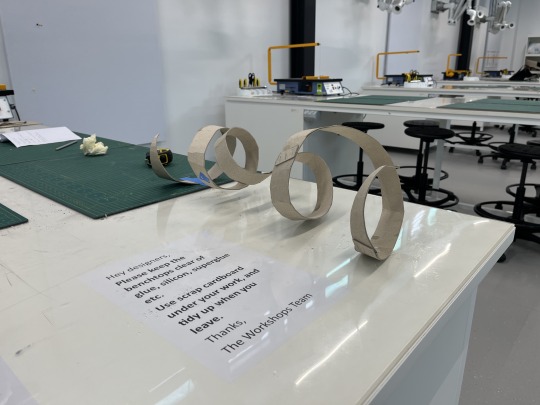
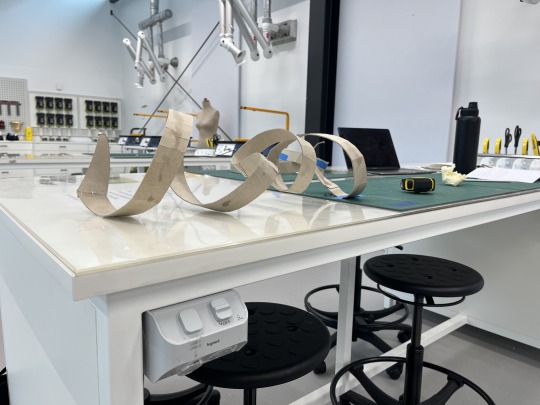
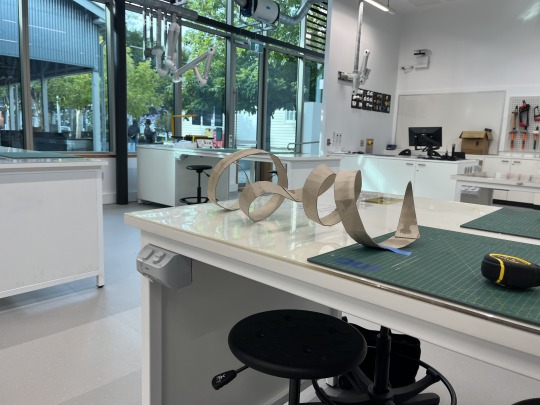
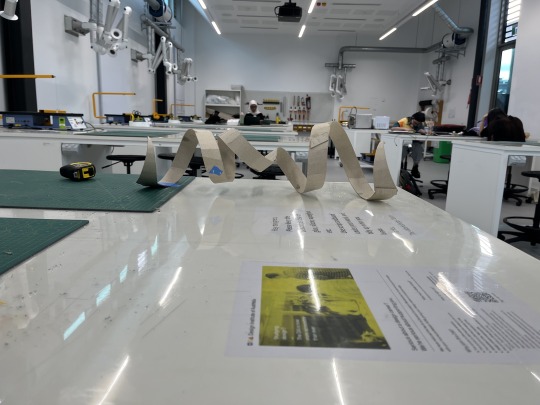
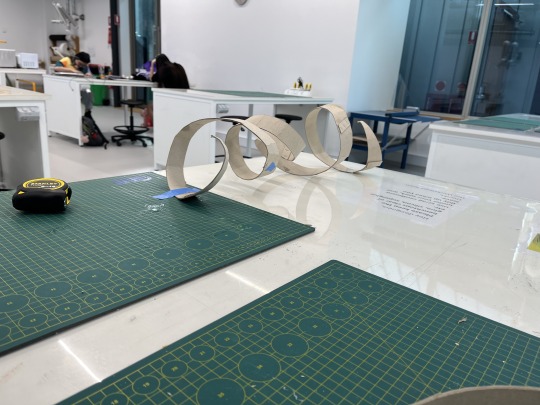
0 notes
Text
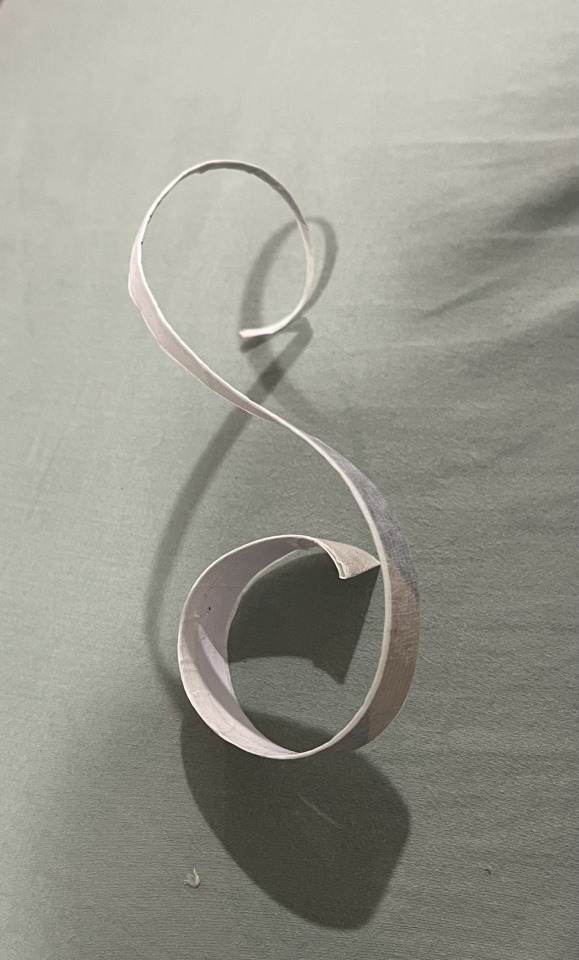
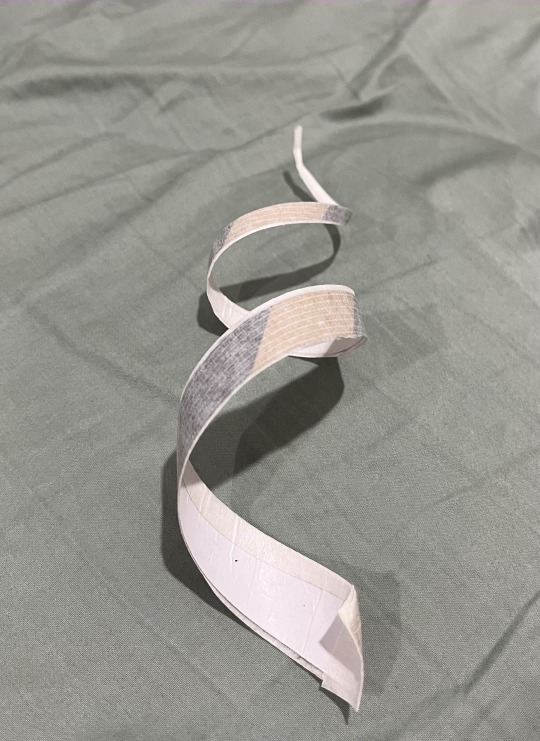
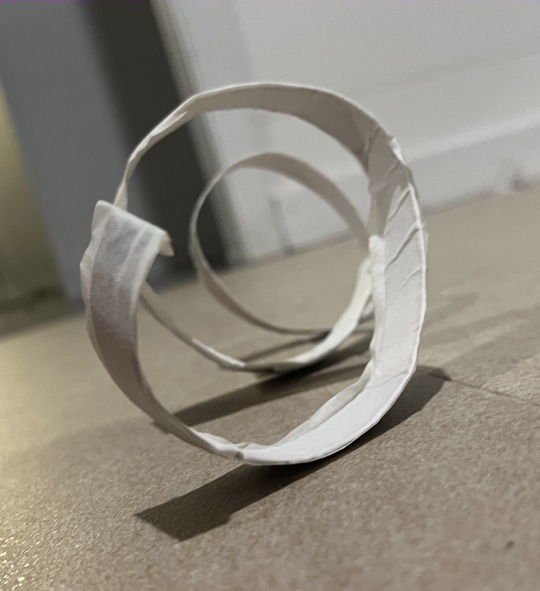
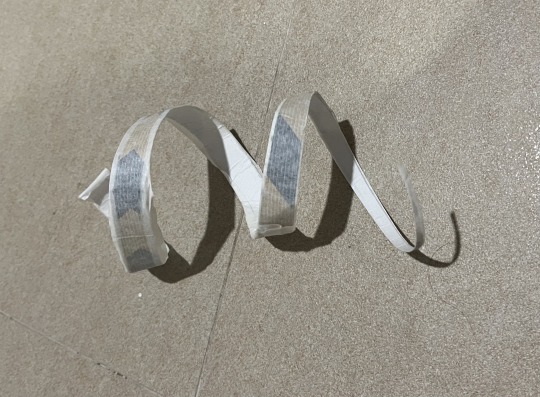
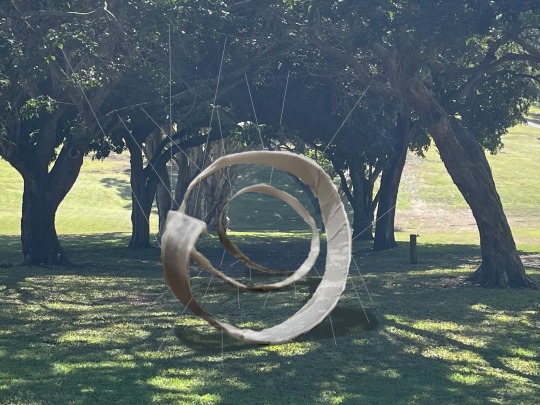


(02/10/2024)
KVB222 -Assessment 2 Journal (Week 10)
Leading up to the presentation I experimented with alternative materials and played with the idea of cardboard or paper. This lead to a series of small modules which lead me to keeping the idea of more biodegradable, recyclable materials which would be more suitable for a short term display. While it is a new approach, it's theme of wind and air flow as discussed in previous entries will remain.
Being a floppier material which is more affected by wind and easy to blow away, it will need to be more firmly secured to the site. It will also require suspension to maintain it's shape.
Presentation Feedback:
Q. How will you maintain the work's form through weather and climate?
A. Suspension from the ground and tree branches.
Q. Have you considered "seed bombing" as the card/paper materials breakdown?
A. Yes, at this stage it requires further investigation but either way the artwork will be mulched after the fair.
Q. What is the name of your work?
A. TBD.
0 notes
Text
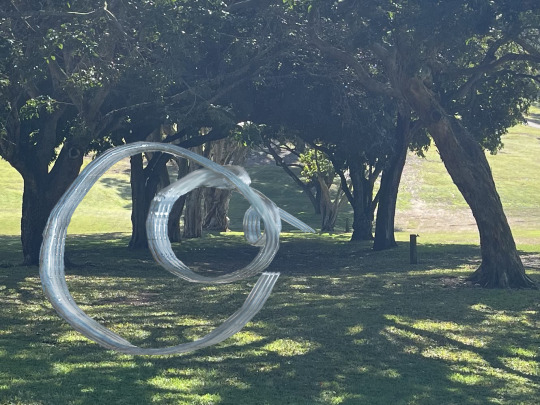
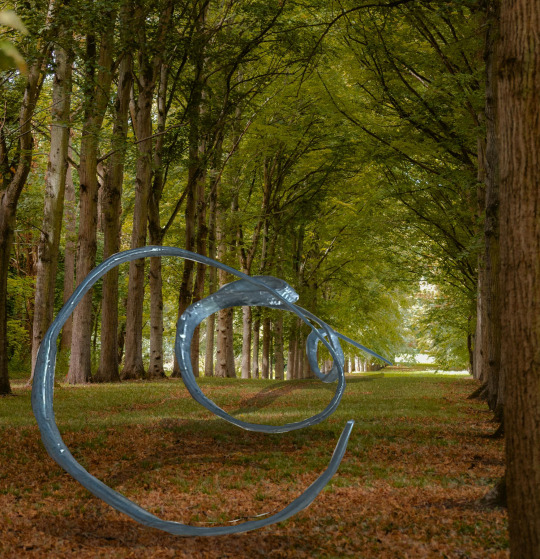


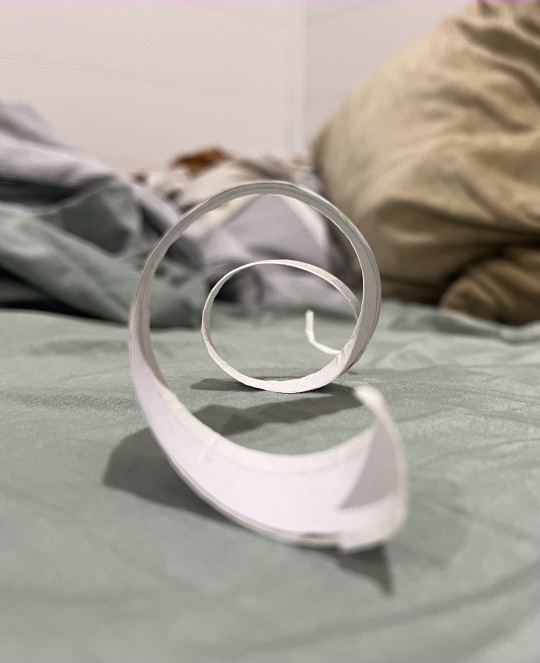
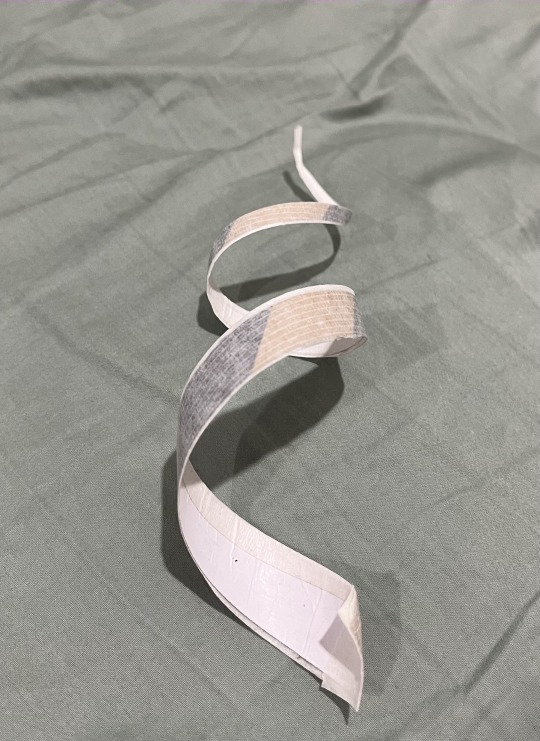
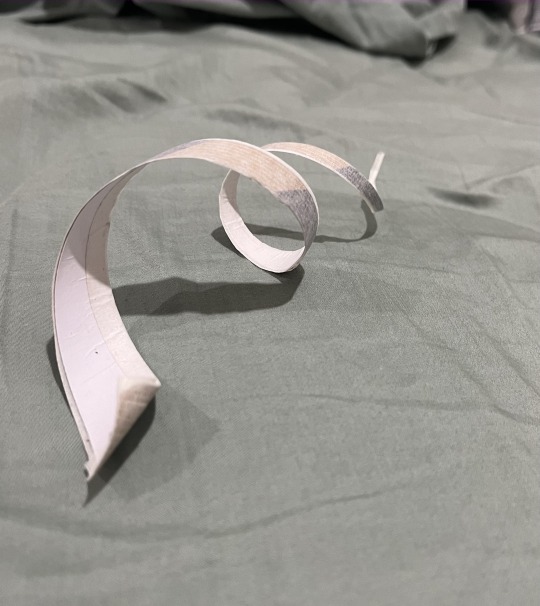
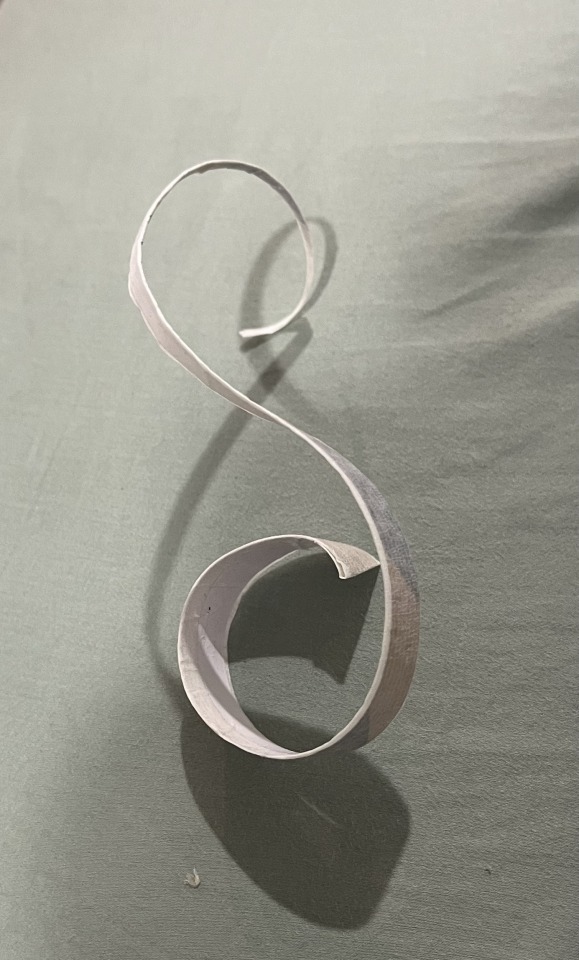
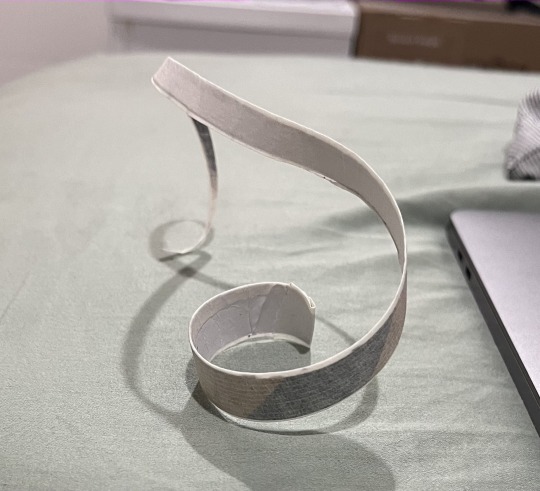
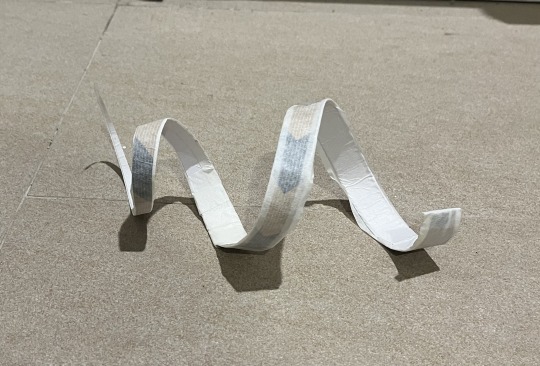
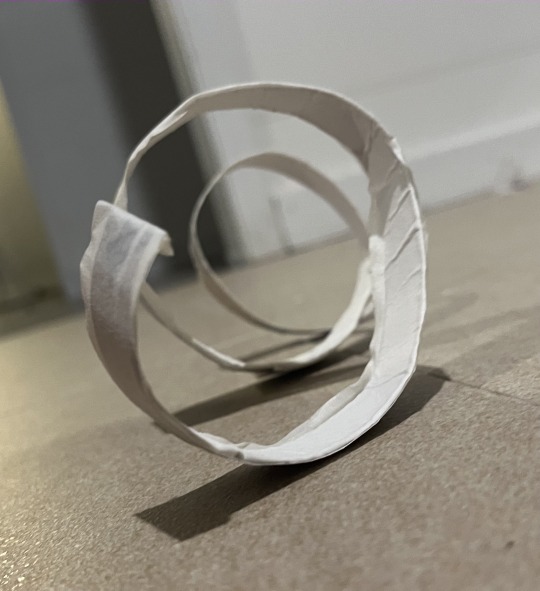
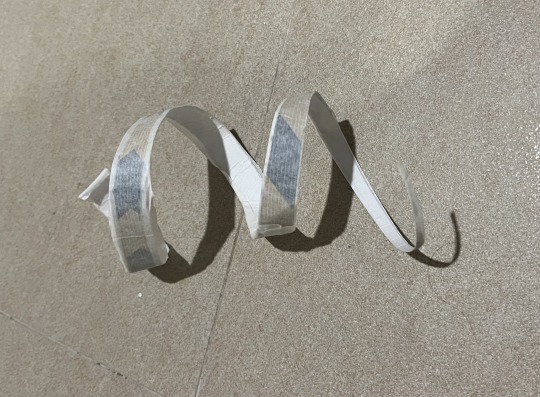
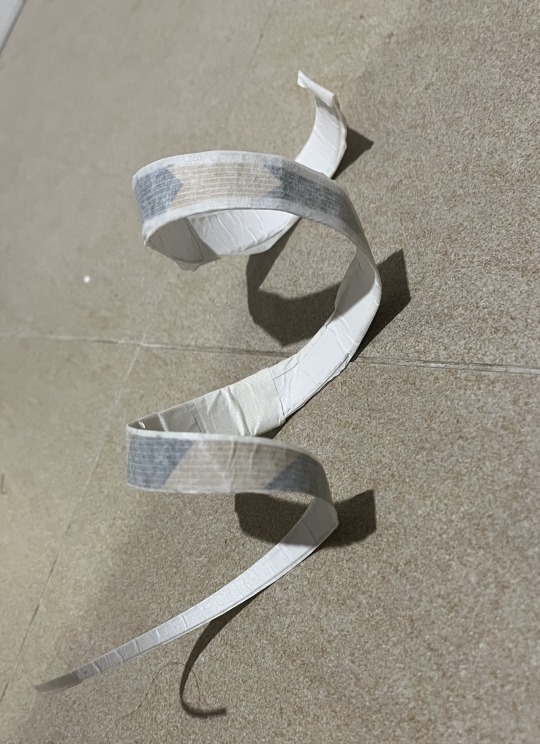
(24/09/2024)
KVB222 -Assessment 2 Journal (Week 9)
The intention for the work is to engage indigenous perspectives of the site through shape and gesture relating to Barrambin's relationship with dance and movement. Barrambin has historically been a significant cultural site to indigenous people, holding gatherings celebrating aboriginal mythology and spirituality through song and dance.
The shape of the structure will also relate to the name of the site, Barrambin, meaning "windy place" in the Turabal Language. The flowing gestures resembling gusts of wind blowing between the trees, imitating their movements.
This Beginning with photoshop mock sketches based on my module from the previous class I created images from both Barrambin and a stock image to envision my work in the site.
After this I began exploring alternative designs intended to be made from card board or wood rather than steel. I have begun to investigate a more regenerative material as the practicality of using steel is becoming less appealing for practicality purposes based on its size, cost and eco-materiality.
0 notes
Text
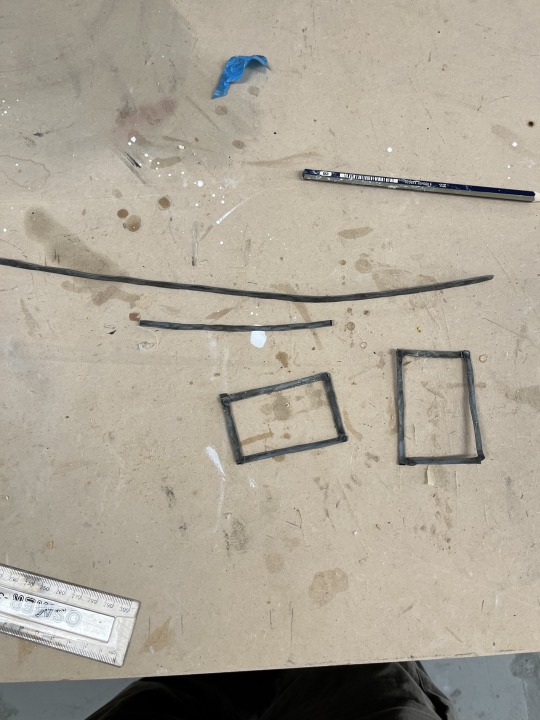
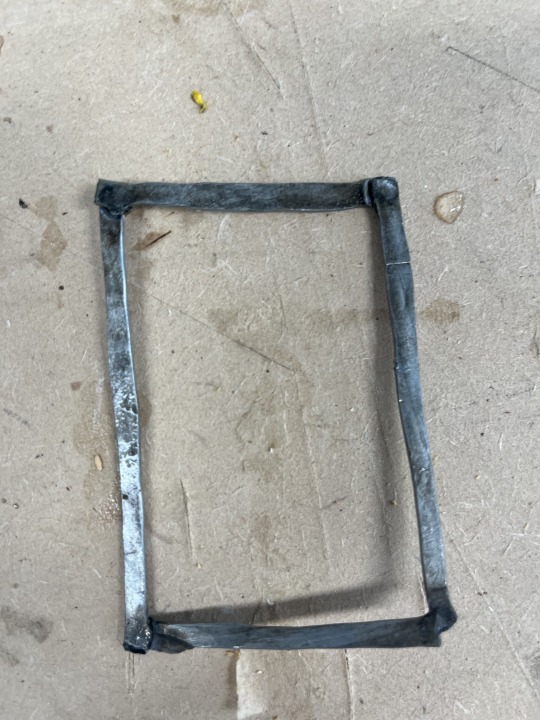
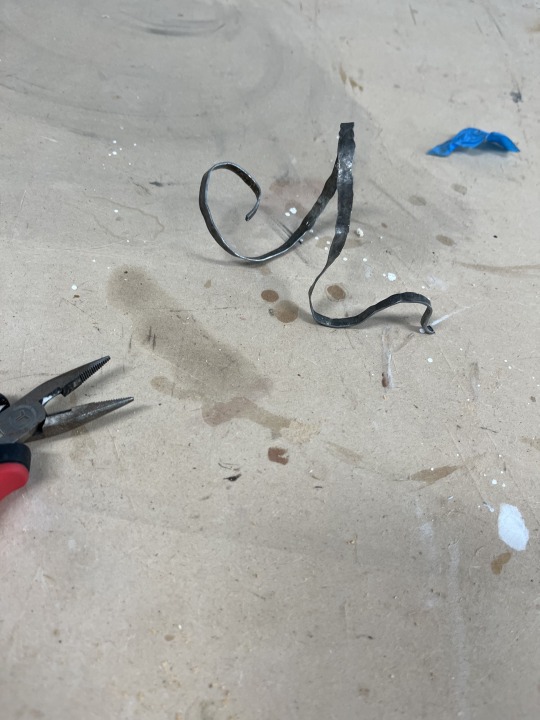
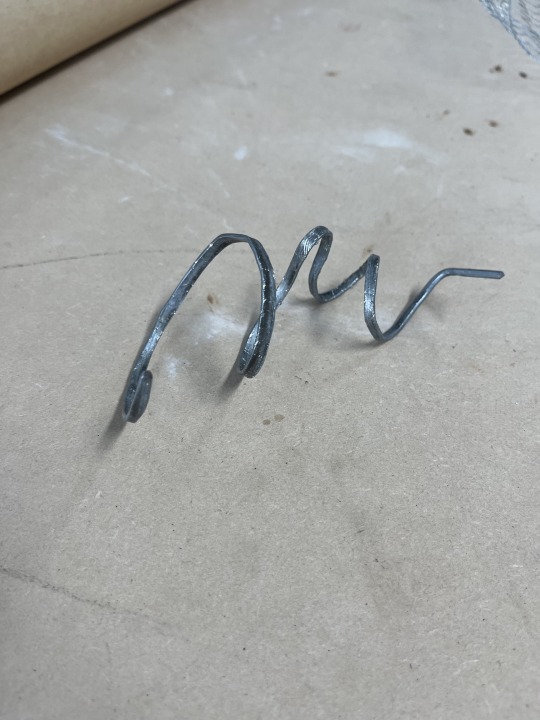
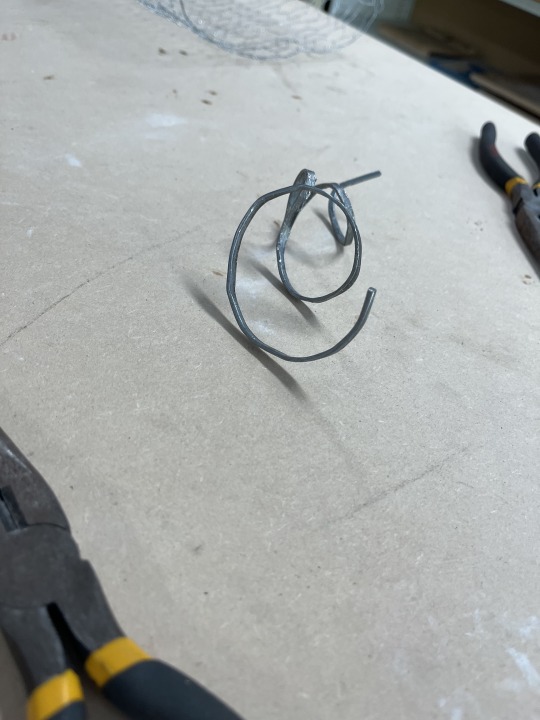
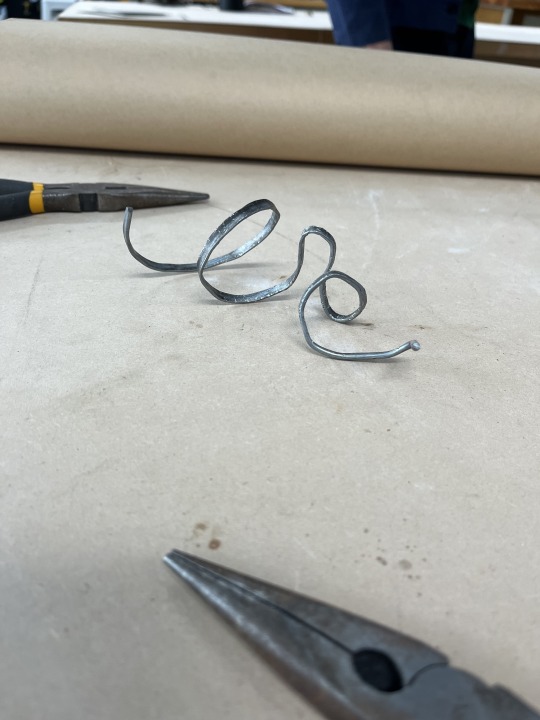
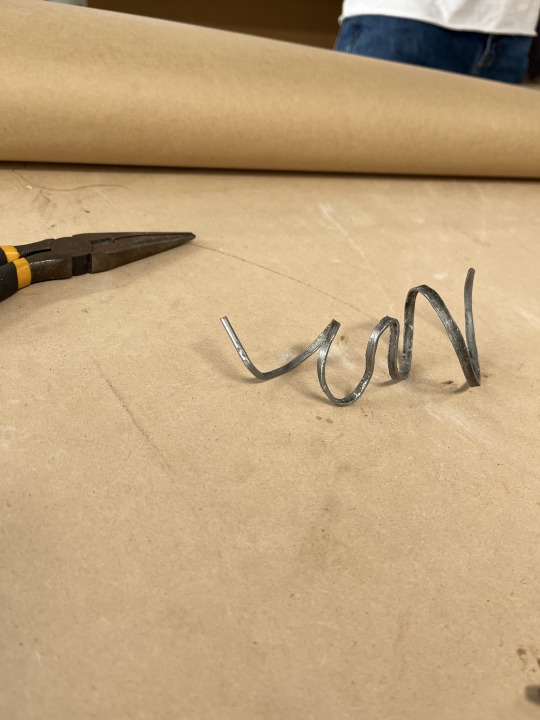
(18/09/2024)
KVB222 -Assessment 2 Journal (Week 8)
Based on the idea I proposed in assessment 1 of a metal movement piece which bends and spirals between rows of trees. I initially began with flattening steel wire on an anvil and then welded pieces together to create steel frame panels. While these were structurally sound and well made, they did not achieve the aesthetic which i had envisioned. I then "shelfed" the idea to experiment with bending the flattened wire on its own and bending it with pliers to create flowing ribbons of steel. This was less time consuming and simplified process however it raises the question of how it could be achieved at full scale.
As to the ecological relevance of the work, its spiraling, winding and flowing gestures are representative of the tree's role of photosynthesis. I plan to accelerate the rusting process using a mixture of vinegar and iodised salt that will be sprayed on the surface of the artwork. The rusting of the piece is important as when it's colours change to more brown and gold tones it will blend into the environment.
As for the historical and cultural relevance, the piece is heavily inspired by the gestures of dance and movement. Barrambin meaning "windy place" in the Turrabul language is a sacred site for indigenous people. Originally used as a gathering site for cultural and recreational purposes such as hunting or corroborees. Corroborees are a celebration of Aboriginal mythology and is accompanied by song and dance. The gestural shapes of the artwork are intended to pay tribute to these celebrations and acknowledge the importance of these practices.
Links
0 notes
Text

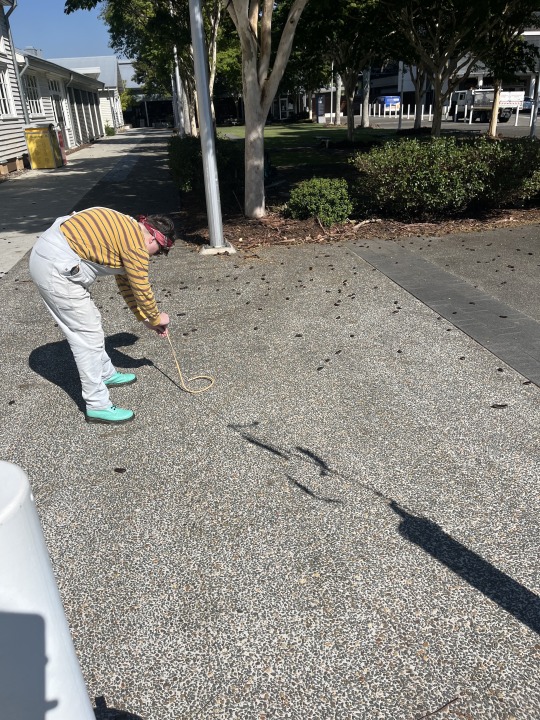

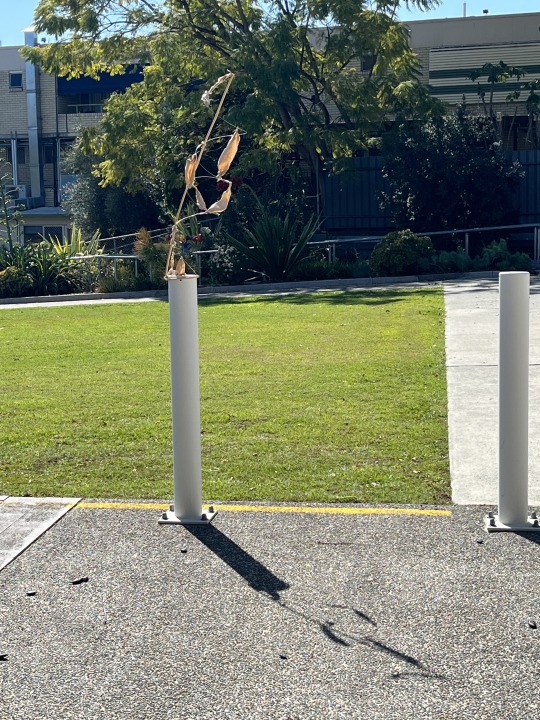
(28/08/2024)
KVB222 - Spatial Art: Object and Site (Week 6)
Anne and I were placed into a group together and given the task of creating a site-specific artwork with the idea of "re-use" in mind. How can this artwork be repurposed on re-used in time? Are the materials it is made from recyclable?
We began by searching for a site which we would install our work, leading us to the white bollards. We started with the idea of repetition and continuation and decided our primary material would be wire for its bendable nature. This later turned into extension after I wrapped wire around the bollard/post and placed it atop itself. This created a spiral-like spring which was flimsy and loose. We wanted it to be more still and stable however, which brought forward the idea of bamboo as a support beam. After discovering the bamboo was also quite bendable it became difficult to straighten the spiral. This lead to experimentation with tension and balance (off the site) until we accepted the direction the bamboo wanted to lean in. When placing it on top of the post again, it felt too empty and faint which resulted in the introduction of paper. This was used to create further dimension and shape. When returned to the bollard it had a firmer, stronger feel and displayed a starker, more expressive shadow.
Upon reflection on this process I would most probably explore a less tension based piece. While it is still a work which was intended to embody the idea of "re-use" and certainly could do so; it was not realised in the same way as it was envisioned. It does however, embody "re-use" more in the sense that the piece itself, is reusable on other bollards and similar shapes. In future I believe I would direct the aspects of "re-use" more toward the materials themselves.
Inspiring Artist(s):
"Cockatoo on the move" is a work by Alan Meyburgh, an Australian artist specialising in works made from recycled materials. The expressive shape of the work distinctly depicts the motion of a cockatoo in soaring in flight. The cockatoo itself is mounted on a steel road which is connected to a base of Jarrah wood. The wood however is sourced from the Cape Leewin Lighthouse which was restored and left Jarrah wood fencing originally from the 1940's. The body of the cockatoo is also made from the original lighthouse fencing and the head and wings from an oil drum sourced from a local property. Speaking to the nostalgic, coastal location on Australia's West coast.

Jordan Sprigg similarly uses recycled materials to create large scale sculptures, often depicting wild life in nature. His 2016 work "The Amelia Park Roo" uses site specificity to create a scene of a kangaroo drinking from a watering hole. The sculpture is made of piece of discarded metal and scrap pieces most probably from old machinery as much of Sprigg's other works. These parts can be seen having been welded together to create the form of a kangaroo. This work is now on permanent public display at the Amelia Park Wines, Margaret River.

Reference(s):
Meyburgh, A. Cockatoo on the Move - Leeuwin Lighthouse Weather Station [Sculpture]. Yallingup Galleries, Yallingup Galleries https://www.yallingupgalleries.com.au/products/cockatoo-on-the-move-leeuwin-lighthouse-weather-station
Sprigg, J. Jordan Sprigg: Sculpter - About the artist. https://www.jordanspriggsculptures.com.au/about
Sprigg, J. (2016). The Amelia Park Roo. jordanspriggsculpter.com.au. https://www.jordanspriggsculptures.com.au/the-amelia-park-roo
0 notes
Text
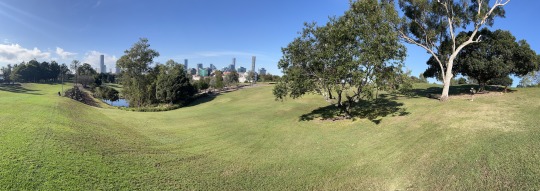
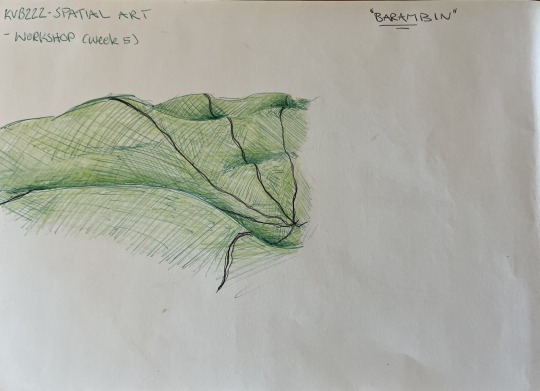
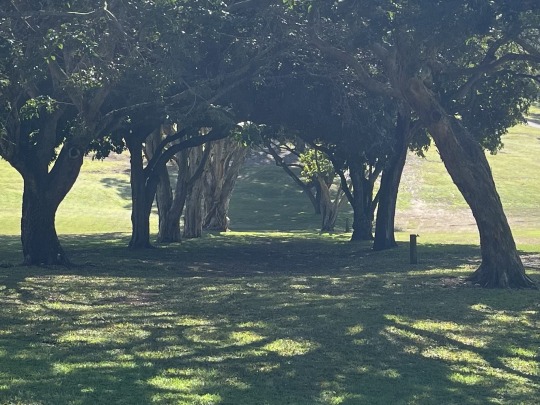
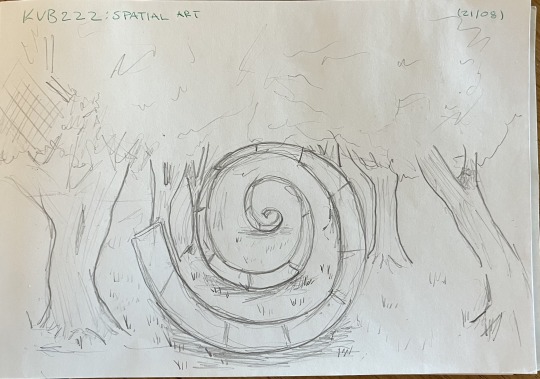
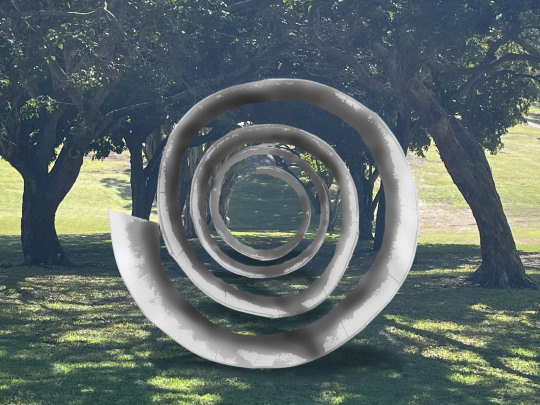
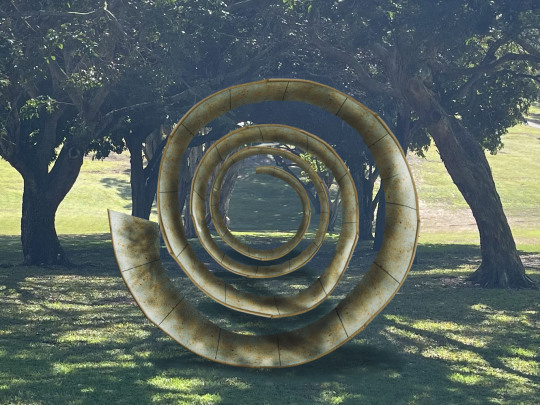
(26/08/2024)
KVB222 - Spatial Art: Object and Site (Week 5)
During the walk through Barrambin (formally Victoria Park) I considered the history of the site, the first nation's history and its environmental history as well. Keith discussed how certain areas of the park were originally parts of a river which had been drained over time after European colonisation. This often causes certain areas of the site to flood with heavy rain fall, and the path the river would previously follow can be seen at the lowest points of the land which resemble river beds.
When we first stopped to take photos and explore the site I observed the highest and lowest points of the landscape. This brought me to sketch the idea of lines of wire or tiles which trace the landscape and meet at the lowest point (potentially where the river bed once was).
However, upon discovering rows of trees at a different location on the site I considered the idea of a spiral of metal panels which could whirl down the centre of the two rows. This larger scale piece would be representative of the important role trees have in our eco-system when photosynthesising. It also speaks to the history of the site and its name, "Barrambin" meaning "Windy Place".
In making these sketches I hoped to express the site's size and rolling winds through a repeating, extending spiral. I decided on metal panels based on the manner they age, beginning shinny and reflecting the site it inhabits, to rusted, blending into the site's natural colours between the trees.
Inspiring Artist(s):
Mark Aeling, an American Site specific Sculptural artist created a work for a new police training centre in Colarado called "Acumen". The work was inspired by a shell fossil specifically discovered across Colorado. The work is representative of the refining process and improvement with repetition, aligning with the site's purpose of police training. The 5.5m tall work is made of stainless steel and weighs an approximate 3583kg and was put together in pieces. Beginning with small rib cage-like steel pieces which were welded together, creating pieces of the artwork to later be joined together.

Richard Serra's "Torqued Ellipses" are another example of site specific spatial art. The series of metal walls which wrap around creating enclosures were designed with the knowledge of the Dia:Beacon Gallery once being a railroad depot factory. The large scale rusted steel sculptures are intended to force the viewer to travel through and around the space, bringing forward the work's sense of movement. Creating an experience of disorientation and confusion for the viewer in the space. The work was created by experimentation with small scale models made of wood and templates rolled in lead, then designed digitally with computer software. To make the shapes and gestures, large sheets of steel were bent using a unique bending tool which had initially been designed for building ships.

Reference(s):
Aeling, M. (2021). MGA Sculpture Studio. LLC: Acumen. https://www.mgasculpture.com/ammonite
Dia. Richard Serra: Long-term view, Dia Beacon. https://www.diaart.org/exhibition/exhibitions-projects/richard-serra-exhibition
0 notes
Text
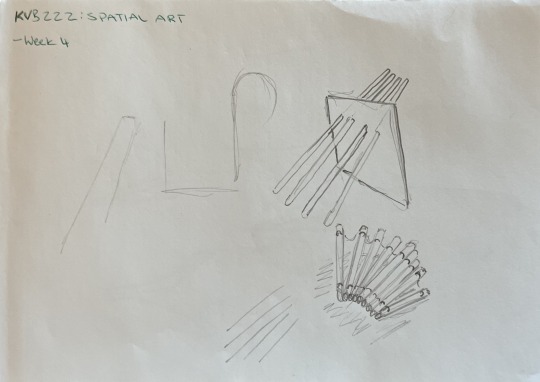
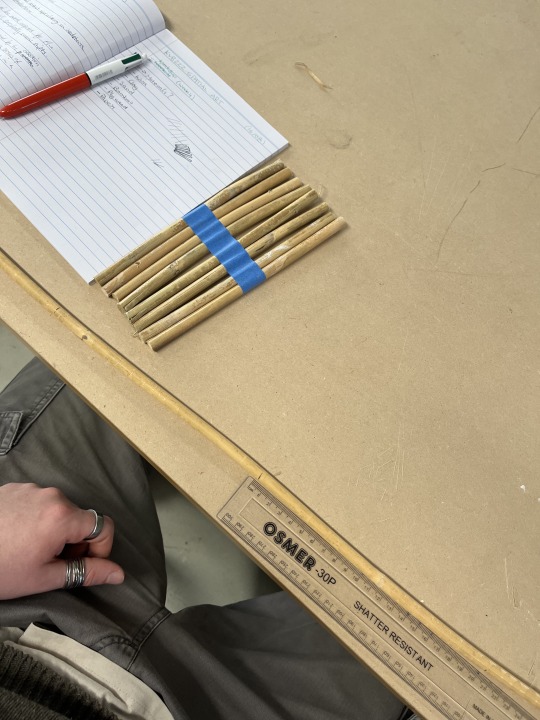
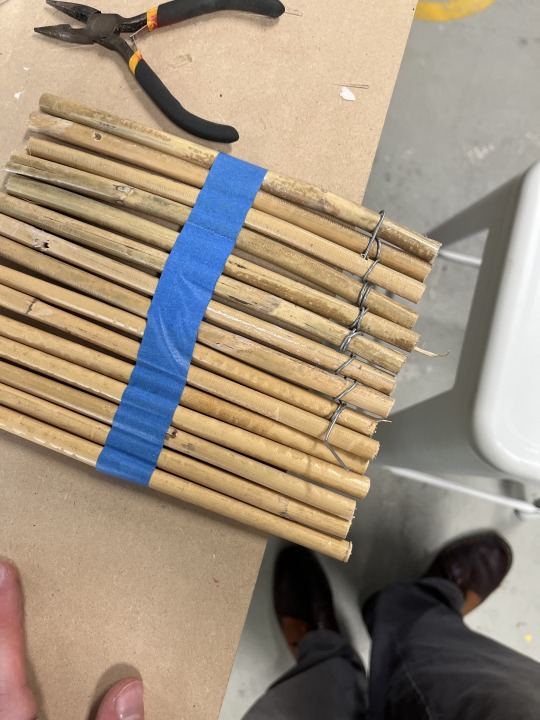
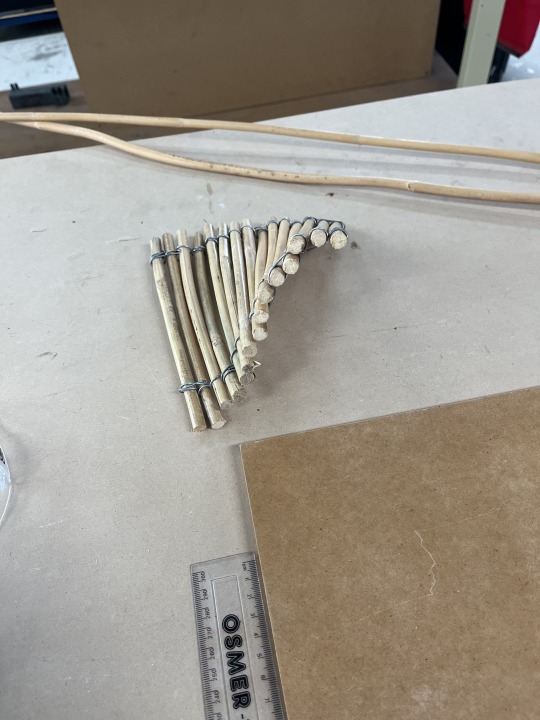
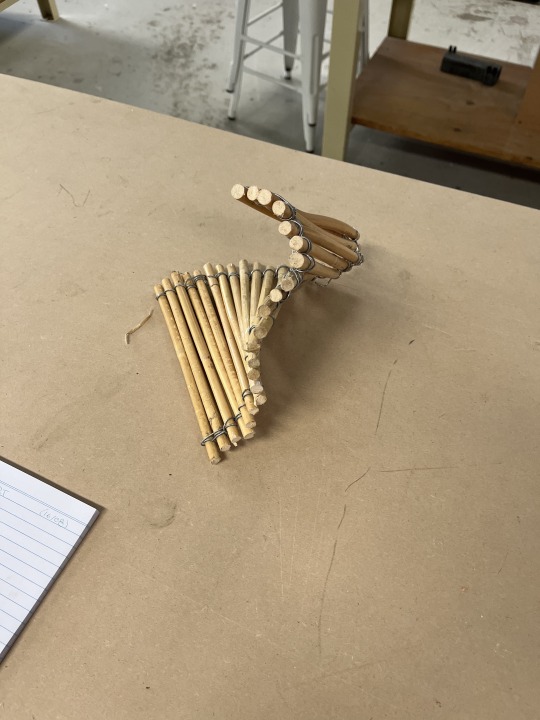
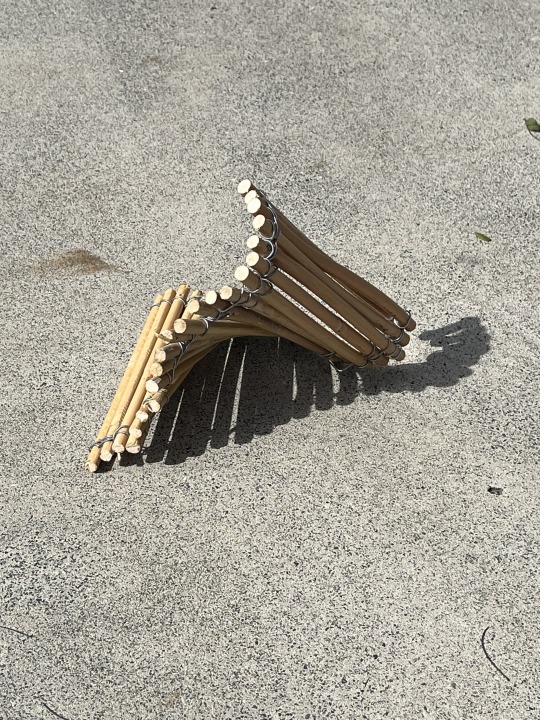
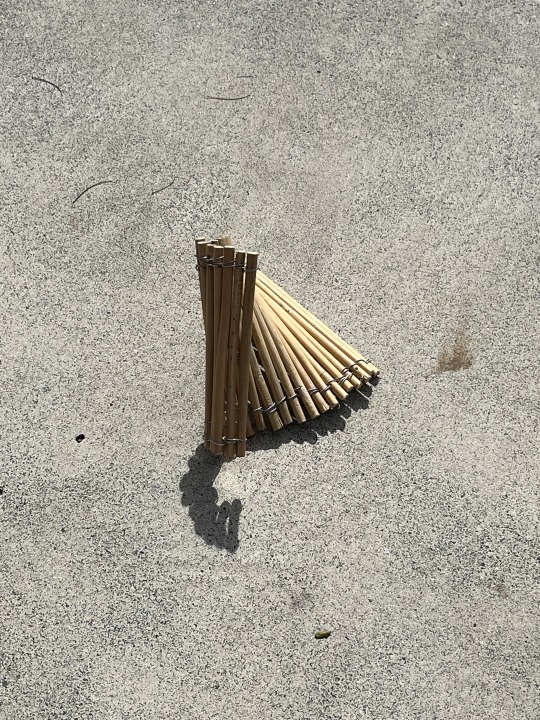
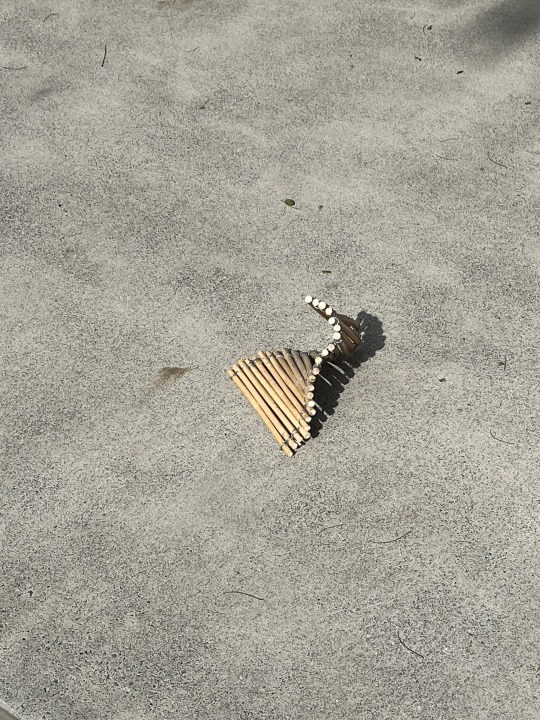
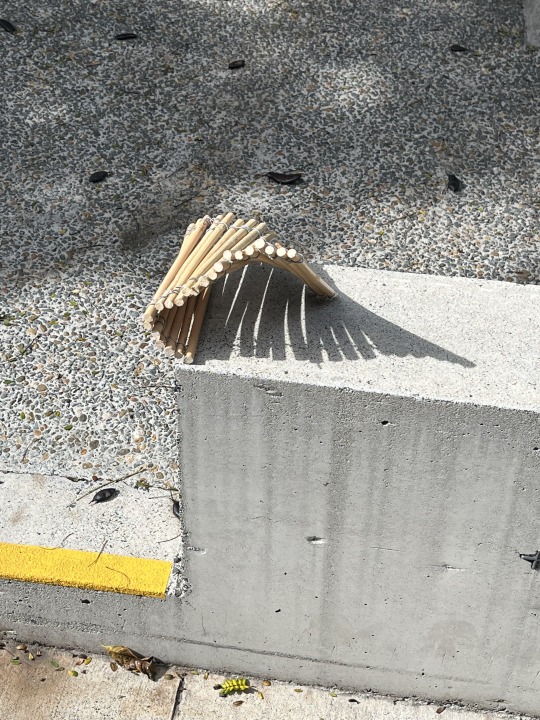
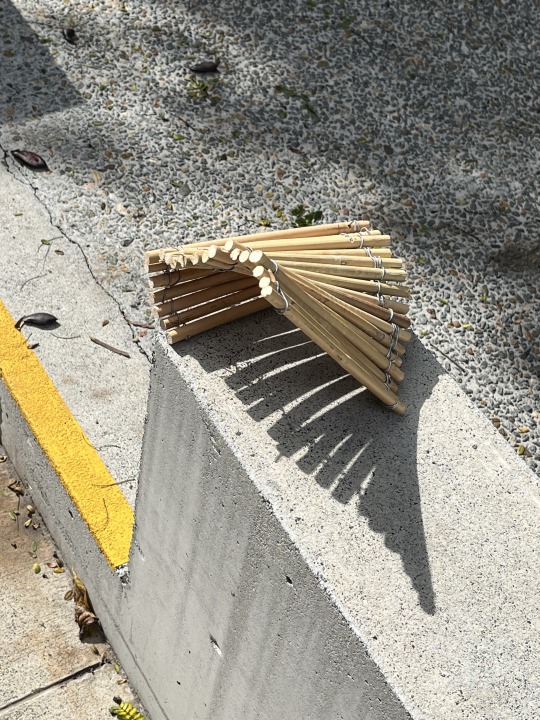
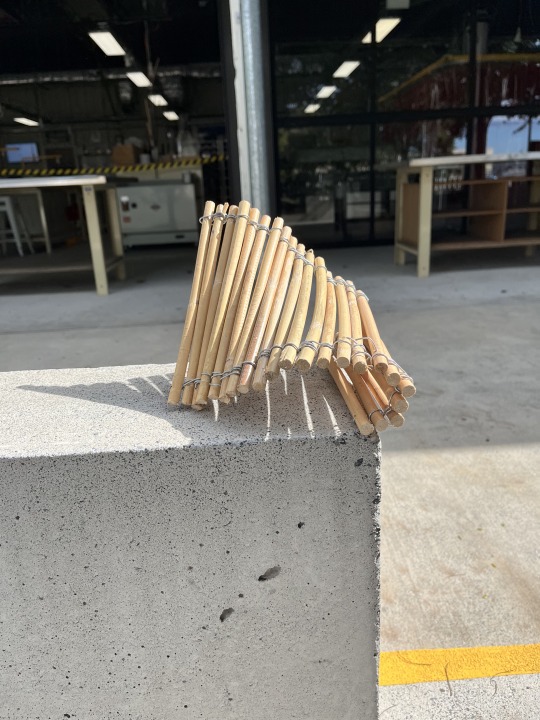
(16/08/2024)
KVB222 - Spatial Art: Object and Site (Week 4)
With this piece I decided to only use bamboo and wire to create a bendable plane which could be molded to fit a site. In my first attempt, I began cutting the bamboo into 20cm pieces, I then drilled holes in both ends of every second or third piece. I threaded the wire through the holes while wrapping it around the pieces in a row.
Upon finishing the row I realized it would need to be extended further as when bending the plane it displayed very little embodiment of motion or fluidity. I repeated the initial process of cutting, drilling and weaving the bamboo pieces and was able to curve and create a greater sense of movement and cast a more expressive shadow.
Regarding site specificity I targeted concrete surfaces to speak on urbanisation and its alienation of natural materials. These specific concrete sites were also selected based on their shade which allows for stark, expressive shadows when in light.
I initially believed the task would be quite simple and require little time however, in reflection it was quite a temperamental and tedious process in weaving the wire between bamboo. I believe next time I would extend the plane further to enhance the illusion of motion and perhaps more thoroughly explore ideas of balance.
Inspiring Artist(s):
Charissa Brock is a sculptural artist specialising in bamboo works with vast experience with glass, basketry and fibers. Charissa's collection of bamboo pieces are predominantly abstract and designed for the purposes of aesthetic over function but can include a range of ecological materials. Her piece, "Helix Oculi" 2014, is a standing spiral of bamboo, glass and linen thread. This work is made of similar materials to my own and includes an equally similar use of curves and plane. I find the incorporation of a wider range of materials to also be interesting and would enjoy potentially matching more ecological materials.

A site specific work which also produced a curved plane is "Great Petition" 2008, by Susan Hewitt and Penelope Lee. The work which was placed outside of Parliament House in Melbourne was designed as a long piece of parchment, acknowledging the 100 year anniversary of women's suffrage. The 20m long piece is comprised of steel and bluestone which depicts a long flowing wave in motion.

Reference(s):
Brock, C. (2014). Charissa Brock Bamboo Sculpture. https://www.charissabrock.com/free-standing-sculpture/
City of Melbourne, “Great Petition” 2008. https://citycollection.melbourne.vic.gov.au/great-petition/
0 notes
Text
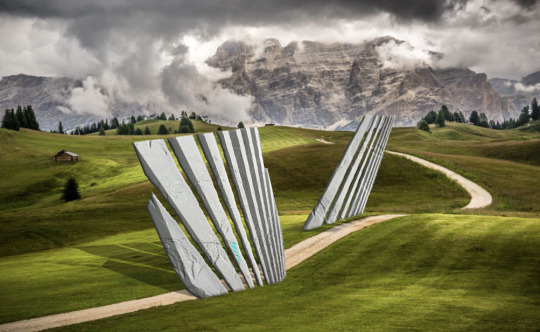
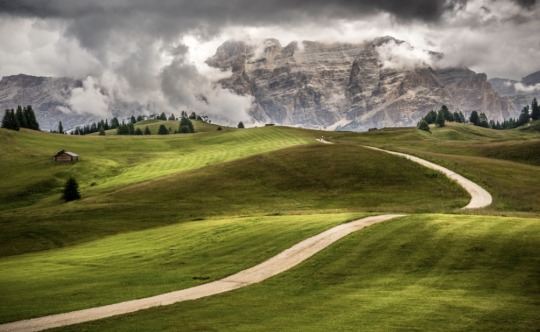
(07/08/2024)
KVB222 - Spatial Art: Object and Site (Week 3)
For this week's task using Photoshop I created a series of standing concrete plane-like pillars which lined a country side path. The concept was inspired by creating contrasts between both light and environmental aesthetic. The planes introducing a very brutal urban tone, sharply shooting from the ground and laying an intense row of shadows across the ground. The concept was developed from an initial contextual approach of the environment which considered the stone mountains in the background and the green rolling hills which reminded me of Stonehenge. This was altered when i noticed the graffiti on the stone images bringing me to the idea of brutal urban architecture contrasting with soft country landscapes.
I would like to consider further on how this could be realised in a more sustainable manner however, while maintaining the contrasting aesthetics.
Inspiring Artist(s):
Stephen Grossman is an American visual artist specializing in sculpture, painting, and drawing. He produces abstract works which relate to the human body. His sculptures are made of sustainable materials such as cardboard, plaster, wood or beeswax. I'm particularly inspired by his works such as "Refuge" 2022 and "Shelter" 2022 which are clearly a product of his training as an architect.

Ian Lazarus is a visual artist specialising in sculptures and installations. Much of his work is inspired by natural processes and the environment, specifically seismic shifts.
His collection "Moments" and my digital design are extremely similar, exhibiting a series of vertical stone pillars emerging from the landscape. Lazarus' work can be seen on a collection of platforms which hold a desert-like landscape and the pillars casting stark shadows across the surface. "Moments" is perceived in many ways but can be interpreted as a representation of deterioration, growth and rebirth.

Reference(s):
Grossman, S. Stephen Grossman. https://www.sgrossman.net/sculpture
Lazarus, I. Ian Lazarus Sculpture and Installations: From temporal topography to seismic shifts. WordPress. https://ianlazarus.com/installations/moments-2/
0 notes
Text
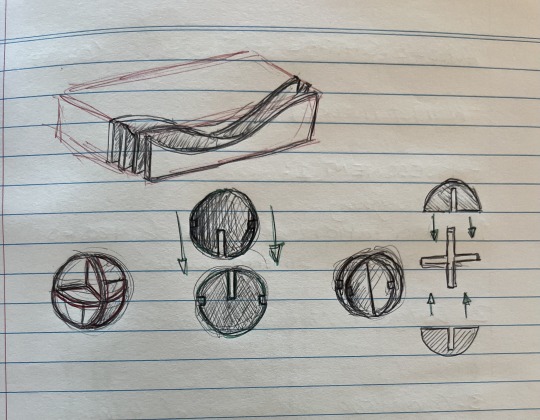
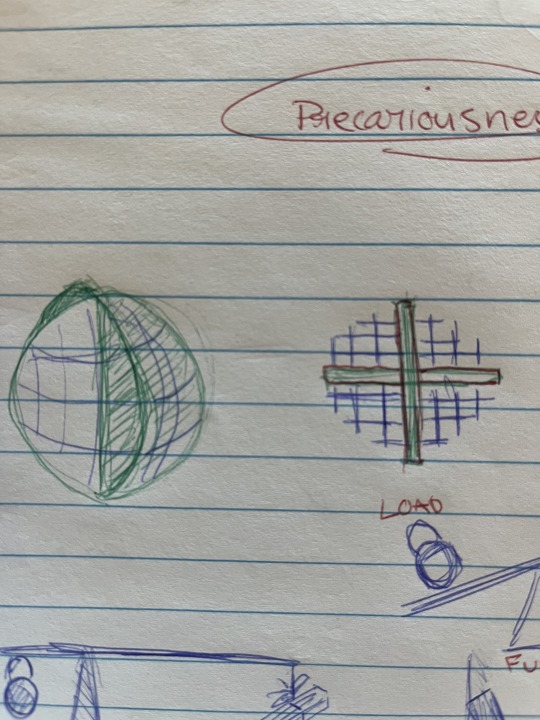
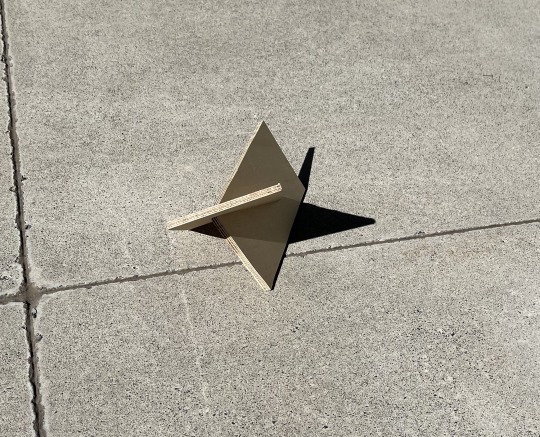
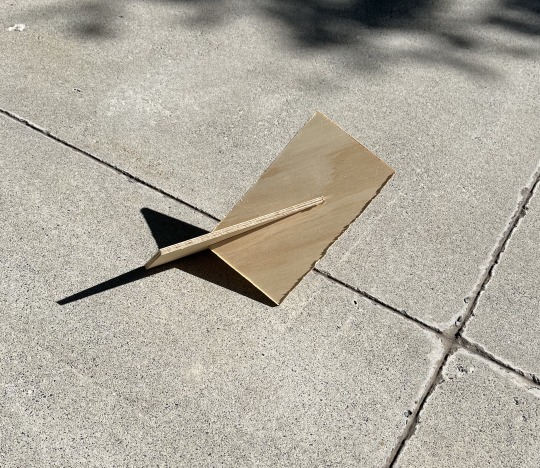
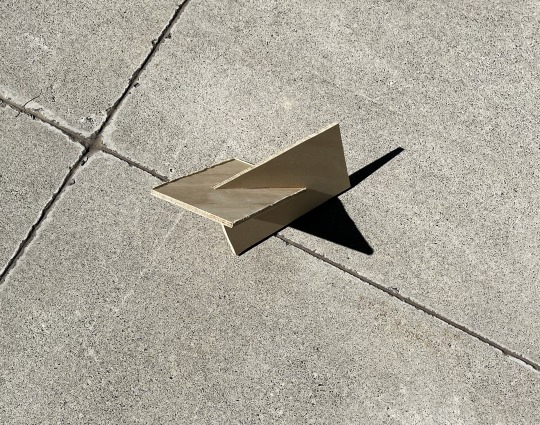
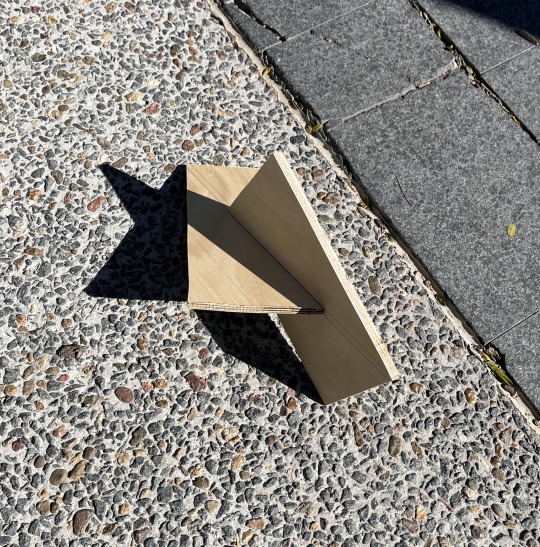
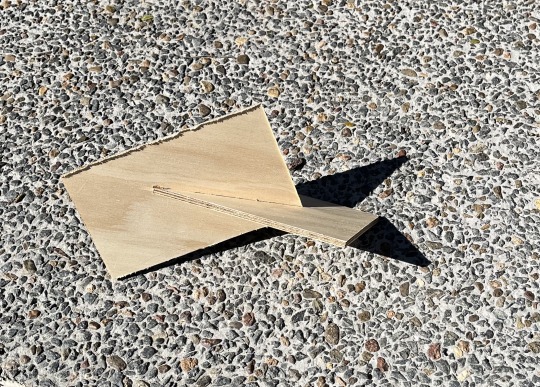
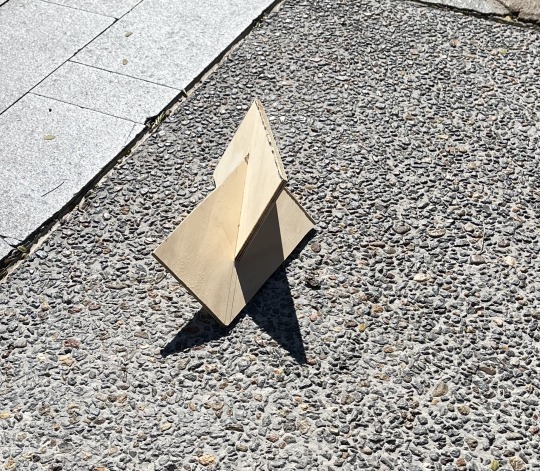
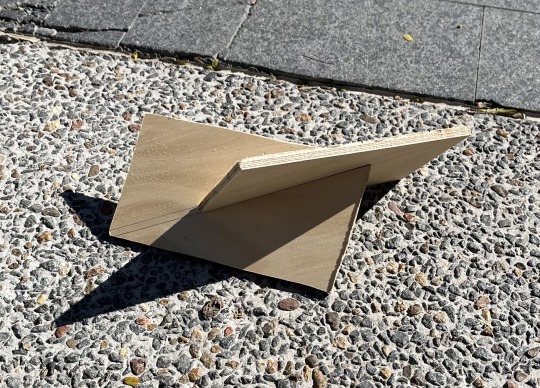
(31/07/2024)
KVB222 - Spatial Art: Object and Site (Week 2)
Focusing on the principles of plane and balance this week I began considering how I could achieve shadows through plane and simple balance. Before beginning I wanted to be more aware with my materials and how I could minimize waste. I had also sketched up ideas on how planes could be connected or joined together without fixatives, leading me to the idea of cutting joints.
Using a plank of plywood from the scrap bin, I began by cutting it in half and cutting joints for them in the center of each half. After ensuring the joints would fit firmly I experimented with different shapes to cut the wood into. Coincidentally after cutting the wood to join into diamond shapes, when joining the wood got caught before reaching the end. Still covering the cut outs and instead taking shape as two rectangles joined together creating two seamlessly connected planes.
I would like to explore the potential for new shapes and forms being connected and their forms of balance. This would also allow for new perspectives and shadows.
Inspiring Artist(s):
Maria Koijck is a Dutch spatial artist with a passion for sustainability. Her artworks are primarily made from recycled single use material including surgical waste. Creating large scale sculptures of wildlife and figures made of materials collected from community waste she speaks on issues regarding pollution and climate change. She has also created a spatial artwork entirely made of surgical waste collected from her own operation. The scrubs, gloves, bags, masks and containers from the surgery were laid out around her as she lay in the centre; the colours and shapes, creating a mandala like effect.

Secondly, Roland Weight; an Australian artist specialising in a range of mediums including painting and sculptural works. His work, "Bench form" made from rusted steel uses planes to create layers of rusted, angled steel with multiple faces. This work similarly aligns with mine which uses balance to create shadows and multiple planed faces.

Reference(s):
Koijck, M. Maria Koijck. Wisemice. Retrieved 07/08 from https://www.mariakoijck.com/
Weight, R. Roland Weight, Artist: Sculpture. https://www.rolandweight.com/sculpture/
0 notes
Text
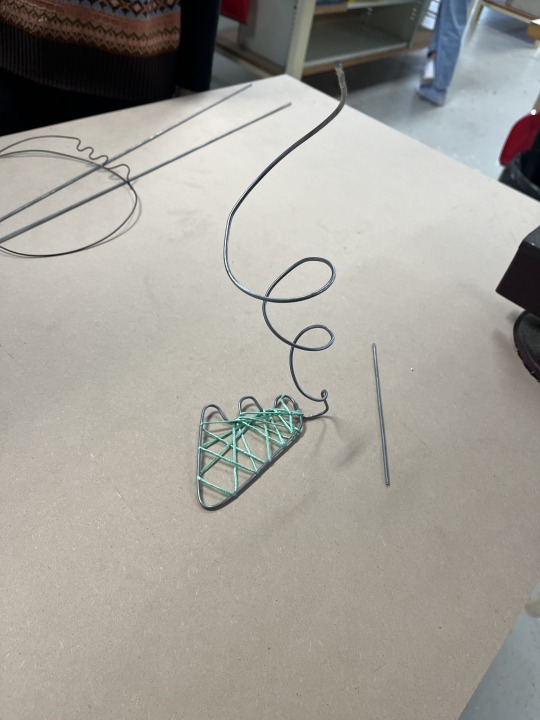
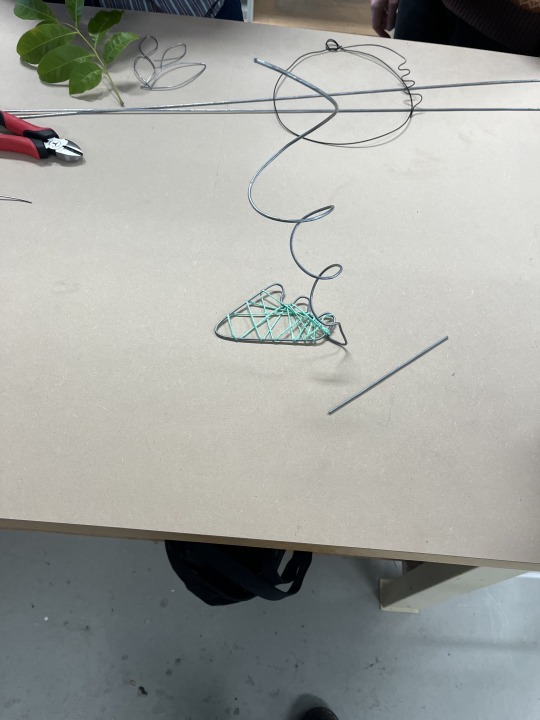
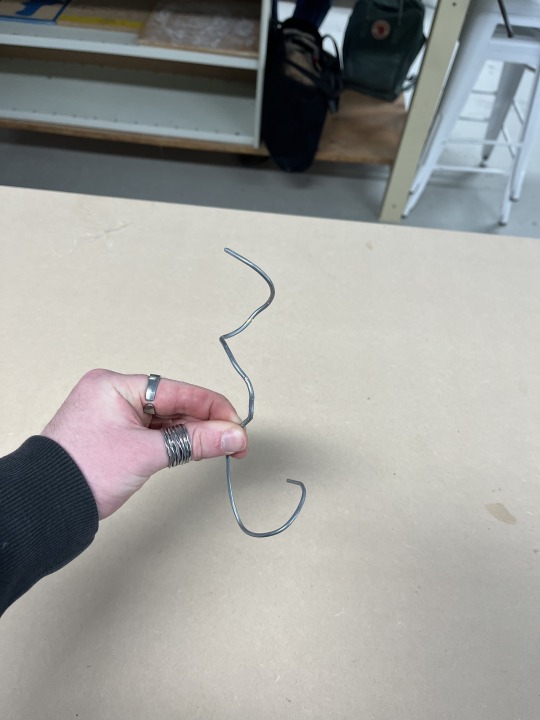
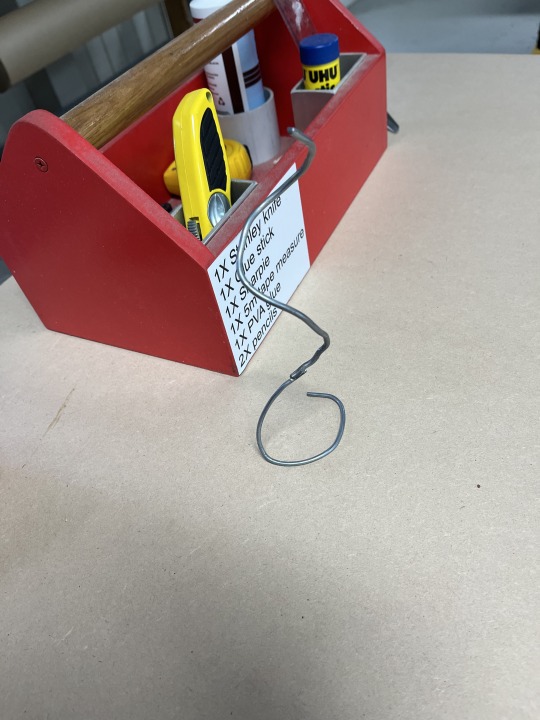
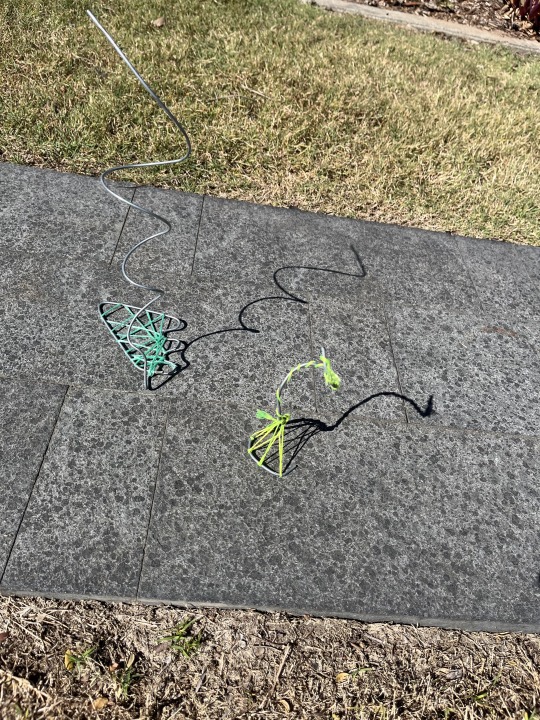
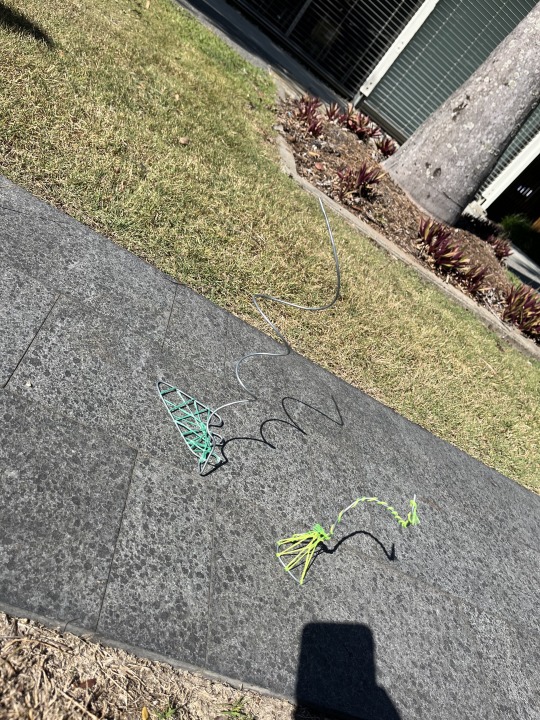
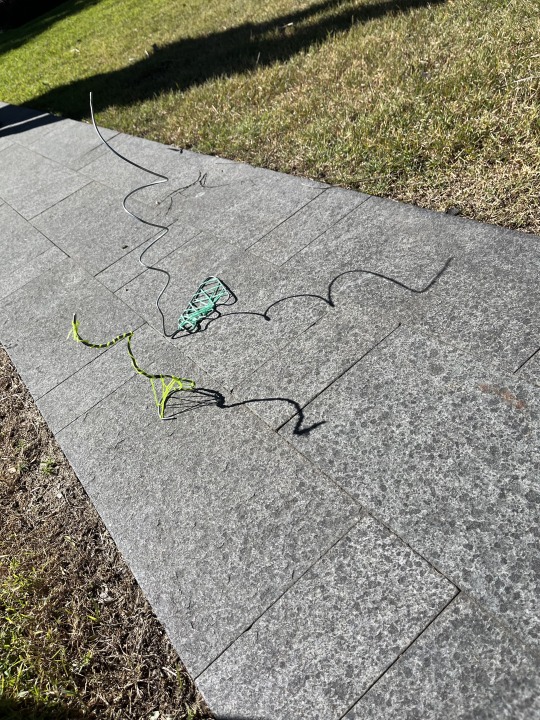
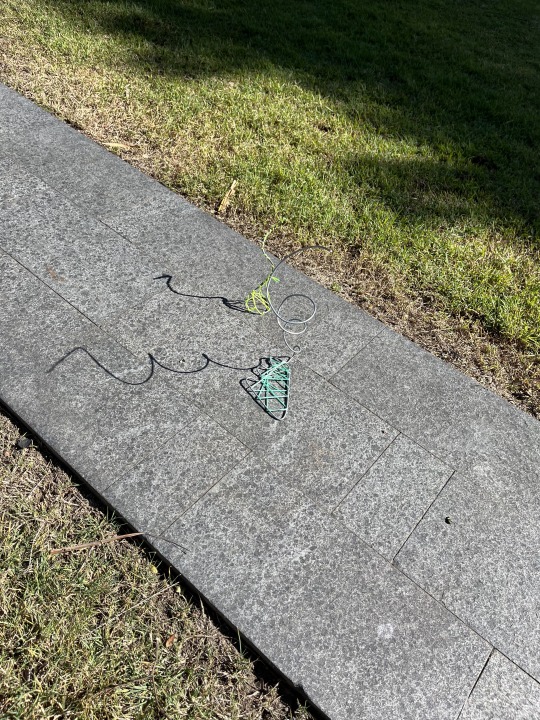
(24/07/2024)
KVB222 - Spatial Art: Object and Site (Week 1)
I began experimenting with the idea of natural occurrences in nature leading me to the concept of a leaf's path of falling. I observed a leaf fall in a swirling swinging motion as if it were going down a drain. This brought me to begin bending a metal rod around into a 3D spiral shape until the end (the most narrow point) where i shaped a flat stand to balance the weight of the piece. Once I bent this back around and welded it together I wrapped a green piece of string around the base to create a leaf like shape.
I then took the piece into the sun to see how the shadows interacted with the shapes. I observed that it changes drastically with the viewer's perspective and when flipped base side up, resembles a lily-pad or plant growing. I then returned to the studio and created a small scale replica wrapped in another green cord which once completed resembled a DNA strand and in the shadow looked like a small leafy plant. From some angles, the shadows created illusions of tension where the shadow and structure meets. Illusions of tension were also seen in the fibers of the string distracting eye from the balance which had been created to hold the piece up.
I think I would like to further explore the ideas of tension in my work and perhaps expand on my incorporation of shapes and colour.
Inspiring Artist(s):
One artist specialising in spatial art who I found particularly interesting is Lucien den Arend. Originally born in Holland in 1943, Arend has created a variety of linear and land art projects over his career. Coincidentally I see much similarity between his 1986, stainless steel artwork, "Europa" and my piece from the workshop in the coil like movements in the metal.

A work by award winning American artist, Serena Bocchino called "Inside out" similarly explores the ideas of balance with wire. The 2017 wire sculpture, is a stationary work which stems from a central fulcrum and hangs down at the boundary of the work's balance. It has (similarly to my work from class) incorporated acrylic fabric to emphasise certain shapes and points of tension.

Reference(s):
Arend, L. D. (1998). Land Art, Sculpture & Site-Specific Art. DutchDeltaDesign Penttilä. https://www.denarend.com/
Bocchino, S. (2017). Stationary & Suspended Sculpture. http://serenabocchino.com/sculpture/
0 notes